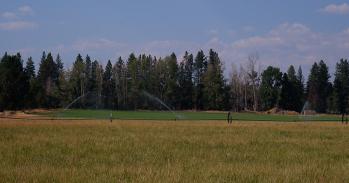
Fundamental research on plant development at the Sainsbury Laboratory will help in the future design of optimal crops.
Fundamental research on plant development at the Sainsbury Laboratory will help in the future design of optimal crops.
Our work aims to understand how plants ‘read-in’ their environment and ‘read-out’ this information as particular patterns of growth and development
Professor Elliot Meyerowitz
A search for answers to the mysteries of plant development lies at the heart of research at the Sainsbury Laboratory, a newly opened institute that was made possible by an £82 million grant from the Gatsby Charitable Foundation. In due course, the Laboratory will house 120 research scientists focused on the multifaceted events that unfold from the moment a single plant egg cell is fertilised.
Understanding plant development is both a fascinating and vitally important intellectual challenge, as Professor Elliot Meyerowitz, the Laboratory’s inaugural Director, explained: “The answers will not only enhance our fundamental understanding of life, they will also have important application to a critical problem that faces the world today – how to feed and fuel a growing population with limited resources of land, water and energy.”
Scientists know some of the structures involved in how a plant develops – the machinery for processing DNA information and the basis of cellular behaviour, for instance. Less is known about the complex communication network that exists across the plant as a whole. The movement of small molecules between cells effectively enables plant cells to ‘talk to each other’ during development and to react to their environment.
“Our work aims to understand how plants ‘read-in’ their environment and ‘read-out’ this information as particular patterns of growth and development,” said Professor Meyerowitz.
Take, for example, branching in plants: how does a plant know where and when to form a branch from its stem, and why does pruning make a plant bushier? Professor Ottoline Leyser, Associate Director of the Sainsbury Laboratory, discovered a hormone network that governs the process. Moving over long distances in the plant, the hormones provide a rich source of information that is then locally interpreted to regulate branching.
“It is this complex web of interaction that makes living organisms more than the sum of their parts,” added Professor Meyerowitz. “Even a small plant can have 10 million cells communicating in a whole variety of different modalities, chemical and physical. There may be 50 different types of plant cells, and each cell might have 30,000 different proteins that might associate and dissociate at millisecond scales, or even less.”
Professor Meyerowitz likens the approach the scientists will be taking to the computer-aided design process used for the Boeing 777 commercial aeroplane: “We’re not designing a plant – it’s already there – but we’re learning how it’s put together. We know what sort of data we want, and we know how to turn it into knowledge using computational models.”
Computational modelling and mathematical and engineering-based approaches will therefore feature strongly alongside expertise in genetics, cell biology, physiology and evolutionary biology within the Laboratory.
Predictive modelling
Professor Meyerowitz studies the genetics of flowering plants, especially the small laboratory plant Arabidopsis thaliana. His team was the first to identify and clone several flower development genes. Two decades ago, they pioneered the re-engineering of flower design, replacing the flowering organs with other organs – a potential 625 possible types of flowers. The scientists can already model many aspects of plant development and then test if the hypotheses about plant behaviour are correct. The future research of the Sainsbury Laboratory will be channelled into such models, with ever-increasing complexity. And, by elucidating the intricacies of plant development, the research will facilitate re-designing crops of the future.
“We’re aimed at 10 or 20, or even 50, years from now so that people can exploit the basic knowledge that we’ve generated, the way the basic knowledge of 30 years ago is being exploited now,” added Professor Meyerowitz. “We’re pretty sure we can figure out how plants develop. It’s not a dream.”
For more information, please contact Professor Elliot Meyerowitz (emm66@cam.ac.uk) at the Sainsbury Laboratory.
This work is licensed under a Creative Commons Licence. If you use this content on your site please link back to this page.





